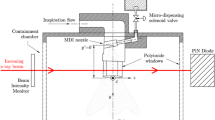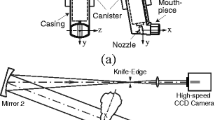ABSTRACT
Purpose
Drug concentration measurements in MDI sprays are typically performed using particle filtration or laser scattering. These techniques are ineffective in proximity to the nozzle, making it difficult to determine how factors such as nozzle design will affect the precipitation of co-solvent droplets in solution-based MDIs, and the final particle distribution.
Methods
In optical measurements, scattering from the constituents is difficult to separate. We present a novel technique to directly measure drug distribution. A focused x-ray beam was used to stimulate x-ray fluorescence from the bromine in a solution containing 85% HFA, 15% ethanol co-solvent, and 1 \( \mu \mathrm{g} \) / \( \mu \kern-.5pt \mathrm{L} \) IPBr.
Results
Instantaneous concentration measurements were obtained with 1 ms temporal resolution and 5 \( \mu \mathrm{m} \) spatial resolution, providing information in a region that is inaccessible to many other diagnostics. The drug remains homogeneously mixed over time, but was found to be higher at the centerline than at the periphery. This may have implications for oropharyngeal deposition in vivo.
Conclusions
Measurements in the dynamic, turbulent region of MDIs allow us to understand the physical links between formulation, inspiration, and geometry on final particle size and distribution. This will ultimately lead to a better understanding of how MDI design can be improved to enhance respirable fraction.










Similar content being viewed by others
Abbreviations
- FWHM:
-
Full width at half maximum
- HFA:
-
Hydrofluoroalkane
- IPBr:
-
Ipratropium bromide
- MDI:
-
Metered dose inhaler
- XFS:
-
X-ray fluorescence spectroscopy
REFERENCES
Prokopovich P. Inhaler devices - fundamentals, design and drug delivery. Woodhead Publishing; 2013.
Dalby R, Suman J. Inhalation therapy: technological milestones in asthma treatment. Adv Drug Deliv Rev. 2003;55(7):779–91.
Rubin BK, Fink JB. Optimizing aerosol delivery by pressurized metered-dose inhalers. Respir Care. 2005;50(9):1191–200.
Preedy EC, Prokopovich P. History of inhaler devices. In: Prokopovich P, editor. Inhaler devices - fundamentals, design and drug delivery. Cambridge: Woodhead Publishing; 2013. p. 13.
Dhand R. Aerosol plumes: slow and steady wins the race. J Aerosol Med. 2005;18(3):261–3.
Crompton GK. The adult Patient’s difficulties with inhalers. Lung. 1990;168(1):658–62.
Dhand R. Ventilator graphics and respiratory mechanics in the patient with obstructive lung disease. Respir Care. 2005;50(2):246–61.
Finlay WH. The Mechanics of inhaled pharmaceutical aerosols: an introduction. Academic Press; 2001.
Buchmann NA, Duke DJ, Shakiba SA, Mitchell DM, Stewart PJ, Traini D, et al. A novel high-speed imaging technique to predict the macroscopic spray characteristics of solution based pressurised metered dose inhalers. Pharm Res. 2014;31(11):2963–74.
Shemirani FM, Church TK, Lewis DA, Finlay WH, Vehring R. Onset of flash atomization in a propellant microjet. ASME J Fluids Eng. 2015;137(9):091101–9.
Dhand R, Malik SK, Balakrishnan M, Verma SR. High speed photographic analysis of aerosols produced by metered dose inhalers. J Pharm Pharamcol. 1988;40:429–30.
Dunbar CA. Atomization mechanisms of the pressurized metered dose inhaler. Part Sci Technol. 1997;15(3–4):253–71.
Duke D, Honnery D, Soria J. A comparison of subpixel edge detection and correlation algorithms for the measurement of sprays. Int J Spray Comb Dyn. 2011;3(2):93–110.
Duke D, Honnery D, Soria J. The growth of instabilities in annular liquid sheets. Exp Thermal Fluid Sci. 2015;68:89–99.
Tzou TZ. Aerodynamic particle size of metered-dose inhalers determined by the quartz crystal microbalance and the Andersen cascade impactor. Int J Pharm. 1999;186:71–9.
Marple VA, Roberts DL, Romay FJ, Miller NC, Truman KG, Van Oort M, et al. Next generation pharmaceutical impactor (A new impactor for pharmaceutical inhaler testing). Part I: design. J Aerosol Med. 2003;16:283–99.
Lewis DA, Young PM, Buttini F, Church T, Colombo P, Forbes B, et al. Towards the bioequivalence of pressurised metered dose inhalers 1: design and characterisation of aerodynamically equivalent beclomethasone dipropionate inhalers with and without glycerol as a non-volatile excipient. Eur J Pharm Biopharm. 2014;86(1):31–7.
Traini D, Young PM, Rogueda P, Price R. In vitro investigation of drug particulates interactions and aerosol performance of pressurised metered dose inhalers. Pharm Res. 2006;24(1):125–35.
Clark AR. MDIs: physics of aerosol formation. J Aerosol Med. 1996;9(S1):19–26.
Liu X, Doub WH, Guo C. Evaluation of metered dose inhaler spray velocities using Phase Doppler Anemometry (PDA). Int J Pharm. 2012;423:235–9.
Smyth H, Brace G, Barbour T, Gallion J, Grove J, Hickey AJ. Spray pattern analysis for metered dose inhalers: effect of actuator design. Pharm Res. 2006;23(7):1591–6.
Haynes A, Shaik MS, Krarup H, Singh M. Evaluation of the Malvern spraytec (R) with inhalation cell for the measurement of particle size distribution from metered dose inhalers. J Pharm Sci. 2004;93(2):349–63.
Als-Nielsen J, McMorrow D. Elements of modern X-Ray physics. New York: Wiley; 2001.
Sinha SK. Application of synchrotron radiation techniques to nanoscience. Radiat Phys Chem. 2004;70(4–5):633–40.
Kastengren A, Powell CF. Synchrotron X-ray techniques for fluid dynamics. Exp Fluids. 2014;55(3):1686.
Kastengren A, Powell CF, Arms D, Dufresne EM, Gibson H, Wang J. The 7BM beamline at the APS: a facility for time-resolved fluid dynamics measurements. J Synchrotron Radiat. 2012;19(4):654–7.
Kastengren AL, Tilocco F, Duke D, Powell C, Zhang X, Moon S. Time-resolved X-Ray radiography of sprays from engine combustion network spray a diesel injectors. Atomization Sprays. 2014;24(3):251–72.
Duke D, Kastengren AL, Tilocco F, Swantek AB, Powell C. X-ray radiography measurements of cavitating nozzle flow. Atomization Sprays. 2013;23(9):841–60.
Kastengren A, Powell CF, Dufresne EM, Walko DA. Application of X-ray fluorescence to turbulent mixing. J Synchrotron Radiat. 2011; 811–815.
Radke CD, Patrick McManamen J, Kastengren AL, Halls BR, Meyer TR. Quantitative time-averaged gas and liquid distributions using x-ray fluorescence and radiography in atomizing sprays. Opt Lett. 2015;40(9):2029–4.
Seitzman JM, Hanson RK. Planar fluorescence imaging in gases. In: Taylor AMKP, editor. Instrumentation for flows with combustion. Academic Press; 1993. p. 405–466.
Bearden JA. X-Ray wavelengths. Rev Mod Phys. 1967;39:78–124.
Krause MO, Oliver JH. Natural widths of atomic K and L Levels, Ka x-ray lines and several KLL auger lines. J Phys Chem Ref Data. 1979;329.
McNaught AD, Wilkinson A. IUPAC compendium of chemical terminology. 2nd ed. Oxford: Blackwell Scientific Publications; 1997. Available from: http://goldbook.iupac.org/A00028.html.
Miller MC. X-Ray Fluorescence. In: Smith K, Reilly E, editors. Passive Nondestructive Assay Manual - PANDA. Los Alamos National Laboratory; 1991. p. 313–335.
Hubbell JH, Trehan PN, Singh N, Chand B, Mehta D, Garg ML, et al. A review, bibliography, and tabulation of K, L, and higher atomic shell X-Ray fluorescence yields. J Phys Chem Ref Data. 1994;23(2):339–64.
Walko DA, Arms DA, Miceli A, Kastengren AL. Empirical dead-time corrections for energy-resolving detectors at synchrotron sources. Nucl Inst Methods Phys Res, A. 2011;649(1):81–3.
Lemmon EW, McLinden MO, Friend DG. Thermophysical properties of fluid systems. In: Linstrom PJ, Mallard WG, editors. NIST Chemistry WebBook, NIST Standard Reference Database Number 69. Gaithersburg: National Institute of Standards and Technology; 1998. p. 20899. Available from: http://webbook.nist.gov.
Dasch CJ. One-dimensional tomography - a comparison of Abel, onion-peeling, and filtered backprojection methods. Appl Opt. 1992;31(8):1146–52.
ACKNOWLEDGMENTS AND DISCLOSURES
The authors thank Dr. Christopher Powell and Dr. Andrew Swantek from the Energy Systems Division at Argonne National Laboratory for their assistance. The authors acknowledge funding support from the Australian Research Council. This research was performed at the 7-BM beam line of the Advanced Photon Source at Argonne National Laboratory. Use of the APS is supported by the U.S. Department of Energy (DOE) under Contract No. DE-AC02-06CH11357.
The submitted manuscript has been created by UChicago Argonne, LLC, Operator of Argonne National Laboratory (“Argonne”). Argonne, a U.S. Department of Energy Office of Science laboratory, is operated under Contract No. DE-AC02-06CH11357. The U.S. Government retains for itself, and others acting on its behalf, a paid-up nonexclusive, irrevocable worldwide license in said article to reproduce, prepare derivative works, distribute copies to the public, and perform publicly and display publicly, by or on behalf of the Government.
Author information
Authors and Affiliations
Corresponding author
Rights and permissions
About this article
Cite this article
Duke, D.J., Kastengren, A.L., Mason-Smith, N. et al. Temporally and Spatially Resolved x-ray Fluorescence Measurements of in-situ Drug Concentration in Metered-Dose Inhaler Sprays. Pharm Res 33, 816–825 (2016). https://doi.org/10.1007/s11095-015-1828-6
Received:
Accepted:
Published:
Issue Date:
DOI: https://doi.org/10.1007/s11095-015-1828-6




